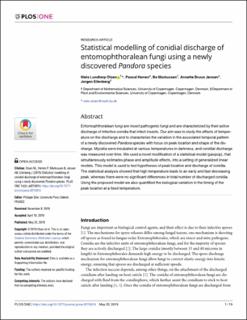Please use this identifier to cite or link to this item:
https://doi.org/10.21256/zhaw-3248| Publication type: | Article in scientific journal |
| Type of review: | Peer review (publication) |
| Title: | Statistical modelling of conidial discharge of entomophthoralean fungi using a newly discovered Pandora species |
| Authors: | Olsen, Niels Lundtorp Herren, Pascal Markussen, Bo Jensen, Annette Bruun Eilenberg, Jørgen |
| DOI: | 10.21256/zhaw-3248 10.1371/journal.pone.0215914 |
| Published in: | PLOS ONE |
| Volume(Issue): | 14 |
| Issue: | 5 |
| Issue Date: | 2019 |
| Publisher / Ed. Institution: | Public Library of Science |
| ISSN: | 1932-6203 |
| Language: | English |
| Subjects: | Conidia; Statistical analysis; Entomophthorales; Pandora; Conidial discharge; Biocontrol |
| Subject (DDC): | 570: Biology |
| Abstract: | Entomophthoralean fungi are insect pathogenic fungi and are characterized by their active discharge of infective conidia that infect insects. Our aim was to study the effects of temperature on the discharge and to characterize the variation in the associated temporal pattern of a newly discovered Pandora species with focus on peak location and shape of the discharge. Mycelia were incubated at various temperatures in darkness, and conidial discharge was measured over time. We used a novel modification of a statistical model (pavpop), that simultaneously estimates phase and amplitude effects, into a setting of generalized linear models. This model is used to test hypotheses of peak location and discharge of conidia. The statistical analysis showed that high temperature leads to an early and fast decreasing peak, whereas there were no significant differences in total number of discharged conidia. Using the proposed model we also quantified the biological variation in the timing of the peak location at a fixed temperature. |
| URI: | https://digitalcollection.zhaw.ch/handle/11475/17178 |
| Fulltext version: | Published version |
| License (according to publishing contract): | CC BY 4.0: Attribution 4.0 International |
| Departement: | Life Sciences and Facility Management |
| Organisational Unit: | Institute of Natural Resource Sciences (IUNR) |
| Appears in collections: | Publikationen Life Sciences und Facility Management |
Files in This Item:
| File | Description | Size | Format | |
|---|---|---|---|---|
| journal.pone.0215914.pdf | Statistical modelling of conidial discharge of entomophthoralean fungi using a newly discovered Pandora species | 2.34 MB | Adobe PDF |  View/Open |
Show full item record
Olsen, N. L., Herren, P., Markussen, B., Jensen, A. B., & Eilenberg, J. (2019). Statistical modelling of conidial discharge of entomophthoralean fungi using a newly discovered Pandora species. Plos One, 14(5). https://doi.org/10.21256/zhaw-3248
Olsen, N.L. et al. (2019) ‘Statistical modelling of conidial discharge of entomophthoralean fungi using a newly discovered Pandora species’, PLOS ONE, 14(5). Available at: https://doi.org/10.21256/zhaw-3248.
N. L. Olsen, P. Herren, B. Markussen, A. B. Jensen, and J. Eilenberg, “Statistical modelling of conidial discharge of entomophthoralean fungi using a newly discovered Pandora species,” PLOS ONE, vol. 14, no. 5, 2019, doi: 10.21256/zhaw-3248.
OLSEN, Niels Lundtorp, Pascal HERREN, Bo MARKUSSEN, Annette Bruun JENSEN und Jørgen EILENBERG, 2019. Statistical modelling of conidial discharge of entomophthoralean fungi using a newly discovered Pandora species. PLOS ONE. 2019. Bd. 14, Nr. 5. DOI 10.21256/zhaw-3248
Olsen, Niels Lundtorp, Pascal Herren, Bo Markussen, Annette Bruun Jensen, and Jørgen Eilenberg. 2019. “Statistical Modelling of Conidial Discharge of Entomophthoralean Fungi Using a Newly Discovered Pandora Species.” Plos One 14 (5). https://doi.org/10.21256/zhaw-3248.
Olsen, Niels Lundtorp, et al. “Statistical Modelling of Conidial Discharge of Entomophthoralean Fungi Using a Newly Discovered Pandora Species.” Plos One, vol. 14, no. 5, 2019, https://doi.org/10.21256/zhaw-3248.
Items in DSpace are protected by copyright, with all rights reserved, unless otherwise indicated.